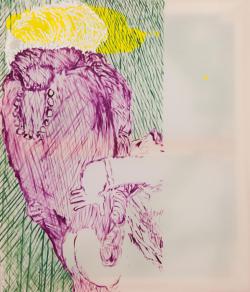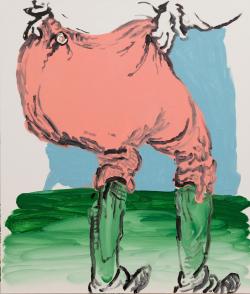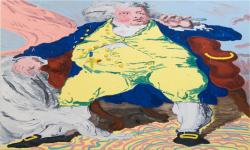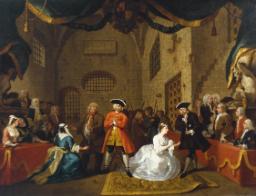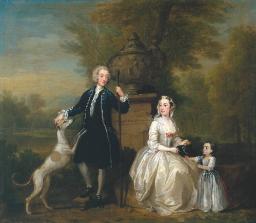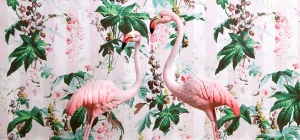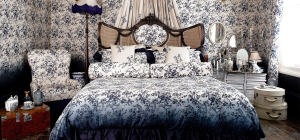Charlie Billingham
“I think being British is probably part of the reason for wanting to look into that heritage and that history.”
Charlie Billingham is a RA graduate artist who specialises in creating humouristic paintings that link to periods of history, in particular he is inspired by 18th and 19th century British Satirical illustrations. His aim is to play on a “reinvention of a representation of English aesthetics.” Billingham claims not to be so interested in Victorian prints but rather Gillray, Cruikshank, Rowlandson and some of the lesser contemporary artists. He explores books and prints to find parts that he appreciates.
The humour of his images is not fixed on any political reverberations however he is interested in how politics becomes archaic over time. He is though more intrigued by the physical elements of the prints and less by the politics. This is why he focusses a lot on both bellies and bottoms in his work. He finds an emotion and intent in the original drawing and closes up on these two body parts which are the most interesting to him. These parts represent the themes of greed and excess which is still a widely sought after topic, even today. He works with oil on linen and uses a pastel palette with candy like colours and Guston like flesh tones.
He works a lot with improvisational painting, although his work has pre made structure and lines, he feels his painting is based around a melody. He compares the repetition in his work to all the remakes of the song My Funny Valentine.
I really appreciate Billingham’s work. I think his mixture of several different intriguing elements reminds me a lot of my working processes. From his History of Art degree in Edinburgh we can see that history is a constant source of inspiration to him. I think he has bypassed the common artists of a time era to explore some who have a lot more character and interest but people are not necessarily in association with them. The way he creates his pieces is something that caught my eye, I find it brilliant that he goes into the studio some days just to think and never to create, that is the purpose of the studio and his evaluation and re-evaluation technique is something that I could take away from this artist.
Wiggle Bum (Yellow Dot) – 2012
Bum 2 – 2012
A Voluptuary Under The Horrors Of Digestion – 2012
Source text:
http://www.ideastap.com/ideasmag/the-knowledge/charlie-billingham-artist-interview
http://shop.royalacademy.org.uk/artsales/charlie-billingham?limit=all
https://www.artsy.net/post/editorial-up-and-coming-charlie-billingham-dusts-off
Source all images:
http://www.saatchigallery.com/artists/charlie_billingham.htm?section_name=new_order
William Hogarth
William Hogarth is an English artist who was also a satirist and a social reformer of his time. Hogarth was an artist of the century of Morris, living from 1697 to 1764. Hogarth started off by painting theatre backdrops but soon became recognised for his morally modern scenes which incorporated an element of darkness and humour. HIs pieces are still compatible with the viewers of today seeing that his main themes of sex, crime and political corruption, are still very relevant. He also did engravings of the financial crisis that hit Britain in the 1720’s, that according to the profile on the BBC would not look out of place in one of today’s newspapers. In 1731 he created a series of six paintings documenting the life of a country girl who turned to prostitution, this series was called A Harlot’s Progress. In 1735, Hogarth founded an academy for the arts. Hogarth defined this period in time with such power and endurance such as no one else has. The Tate class him as the Britain’s first modern artist.
Hogarth never had a patron who would buy his work, he sold his own work. He was really interested in society and how he could improve it, this lead to his founding a hospital for abandoned children. He is now regularly seen as one of the founding fathers of British Art.
The first thing that I am seeing a lot in how much Hogarth’s works could be transferable and really have been painted or engraved today. Although the Tate classes Hogarth as a modern artist at the time when he was creating his images he would have had no idea what was to come after him. This is why I am not sure of how modern he really is, he was simply painting his reality. Looking back now it is interesting to see how relevant his pieces are is the most surprising elements. He has the advantage over other painters and engravers because his works are still so relatable that they draw in the viewer in a way that most artists of that century cannot.
A Scene from ‘The Beggar’s Opera’ VI – 1731
Ashley Cowper with his Wife and Daughter – 1731
Three Ladies in a Grand Interior (‘The Broken Fan’) – c.1736
Sources text :
http://www.tate.org.uk/whats-on/tate-britain/exhibition/hogarth
http://www.bbc.co.uk/arts/yourpaintings/artists/william-hogarth
http://www.tate.org.uk/whats-on/tate-britain/display/bp-spotlight-william-hogarth-1697-1764
Source all images :
http://www.tate.org.uk/art/artists/william-hogarth-265
House of Hackney
Hannah encouraged me to look up House of Hackney who are a British Interiors company whose original aim was to take the beige out of interior design with priority put on quality design and a Made in England ethic. The House of Hackney was founded in 2010 by Husband and Wife ,Javvy M Royle and Frieda Gormly. After a period of bland minimalist interiors, the couple captured Zeitgeist with its collection of British Made prints and products which are modern, bold and rebellious and moved away from previous tradition.
They now have three stores in London including their flagship store in Shoreditch.
Looking through the website for the store, I love the aesthetics of each individual print and product and how they speak to each other. Some of the patterns are really modern but work in each setting they have been placed even if the furniture is old fashioned. II think the interiors each print has been placed in really works together, even though sometimes the pattern is highly repetitive. The names are attention catching and that is also something I aimed to take on in my samples. I noticed that the wallpapers have been presented similarly to mine in terms of how the wallpaper samples are set up.
I really wish I had discovered this company before I started my wallpapers because it is an excellent source of inspiration and ideas. The presentation is something I would have appreciated studying further.
Castanea
Palmeral
Dalston Rose Wallpaper
Source text:
http://www.houseofhackney.com/our-story
Source all Image :
